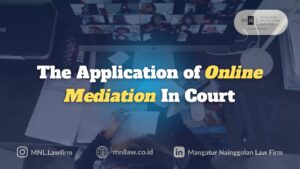
Introduction
The Supreme Court of the Republic of Indonesia has issued Supreme Court Regulation Number 3 of 2022 concerning Mediation in Courts Electronically (“Perma No. 3/2022”). This Perma accommodates litigants so they no longer need to physically appear in court for mediation, thus addressing conditions such as pandemics, natural disasters, or geographical barriers that might cause the parties’ absence.
Implementation of Electronic Mediation
Electronic Mediation is an alternative form of mediation in court when the parties choose to undergo the mediation process by utilizing electronic means. Based on the provisions of Article 1 of Perma No. 3/2022, electronic mediation is defined as: “A method of dispute resolution through a negotiation process to reach an agreement between the parties with the assistance of a mediator, conducted with the support of information and communication technology.”
In its implementation, electronic mediation can only be carried out if both parties agree. If one party does not agree, the mediation will proceed conventionally. This agreement is stipulated in a consent form provided by the court. Mediators, whether judges or certified non-judges, will facilitate the mediation process using an agreed-upon application or virtual space. This virtual mediation space is considered a legitimate mediation venue (vide Article 12 of Perma No. 3/2022).
The mediator is tasked with verifying the identity of the parties, scheduling meetings, determining the virtual mediation space, and guiding the mediation process online. If any party has limited access, they may use a designated mediation room. The success or failure of the mediation will be reported by the mediator to the panel of judges electronically through the Court’s Information System. If the mediation is successful, the parties can sign the peace agreement electronically using an electronic signature.
Obstacles to the Implementation of Electronic Mediation
- Limited Access to Technology and Internet:Not all parties have access to adequate devices and a stable internet network, especially in remote areas. The success of online mediation heavily depends on sufficient digital infrastructure.
- Low Digital Literacy:Both the parties and the mediators may not be accustomed to using online applications or court information systems, thus requiring training and familiarization.
- Dependence on Party Agreement:Article 5 explains that electronic mediation can only be conducted if all parties agree. If one party refuses, the process reverts to manual mediation. This can hinder the efficiency expected from the electronic mediation system.
- Suboptimal Identity Verification:Although Article 9 provides room for face-to-face meetings for identity verification, implementing this practice can be challenging if the parties are in different locations or face physical barriers.
- Risk of Confidentiality and Data Security Breach:Although Perma No. 3/2022 already outlines the principles of confidentiality and prohibits recording in Articles 19 and 20, the potential for data leakage or misuse of electronic information remains a concern.
Conclusion
Perma No. 3/2022 represents the Supreme Court’s adaptation to contemporary challenges and technological developments in the judicial system. Electronic mediation is a progressive and responsive alternative dispute resolution mechanism for the needs of modern society.
However, its success heavily depends on the commitment of all parties to support the infrastructure, enhance digital literacy, and ensure system security. Without adequate technical and social support, the primary goal of electronic mediation—achieving simple, fast, and low-cost justice—will be difficult to realize optimally.
Legal References
- Peraturan Mahkamah Agung Nomor 3 Tahun 2022 Tentang Mediasi di Pengadilan Secara Elektronik (Supreme Court Regulation Number 3 of 2022 concerning Mediation in Courts Electronically).
- Peraturan Mahkamah Agung Nomor 1 Tahun 2016 tentang Prosedur Mediasi di Pengadilan (Supreme Court Regulation Number 1 of 2016 concerning Mediation Procedures in Courts).
Writer: Gracia, S.H. & Evy Mutiara Marpaung
Editor: Muhammad Arief Ramadhan, S.H.
